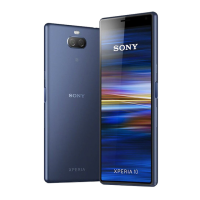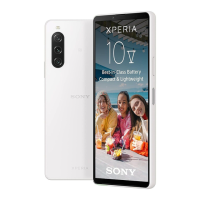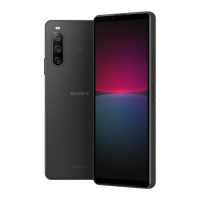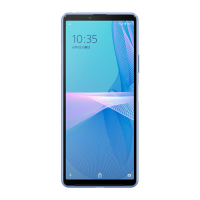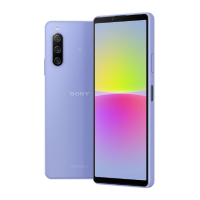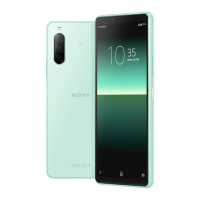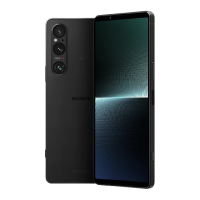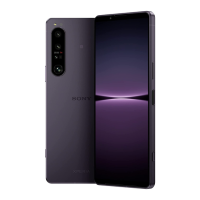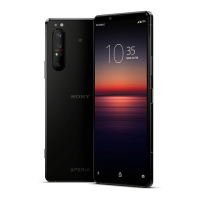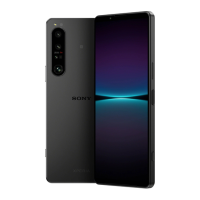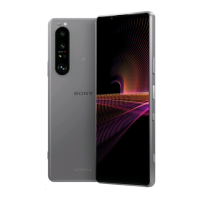Do you have a question about the Sony Xperia 10 Plus and is the answer not in the manual?
Using Google's Find My Device to locate, lock, or erase a lost device.
Instructions for charging the device using appropriate cables and chargers.
Managing battery life with power-saving features and monitoring consumption.
Importance of updates and how to check for new software wirelessly.
Updating device software via wireless download and configuring auto-updates.
How to force restart or shut down the device if it becomes unresponsive.
Steps to reset the device to factory settings, including data backup.
Using Xperia Companion for software repair and troubleshooting.
Using Google account to back up and sync data like contacts, photos, and apps.
Syncing email, calendar, contacts, photos, apps, and files with Google.
Transferring files using a USB cable connection to a computer.
Configuring mobile data for internet access and MMS.
Connecting to wireless networks for internet access.
Configuring Wi-Fi notifications, auto-connect, and viewing MAC address.
Dialing numbers manually, using smart dial, and making calls with Dual SIM.
How to read, send, reply, and forward messages.
Identification of camera components and basic functions.
Ways to open the camera application.
How the shutter button functions in different camera modes.
Adjusting the photo or video aspect ratio.
Accessing and modifying various camera settings.
Selecting different modes for taking photos and videos.
Overview of various camera capturing modes.
Changing between photo/video modes and front/main cameras.
Using pinch gestures or volume keys to zoom in and out.
Capturing a photo by tapping anywhere on the screen.
Applying the Bokeh effect for background blur.
Using augmented reality effects in photos and videos.
Applying creative filters and color effects to photos and videos.
Taking wide-angle and panoramic photos.
Adding slow motion effects to recorded videos.
How camera adjusts to light and optimizing conditions for better photos.
Using and adjusting the camera flash settings.
Adjusting color, brightness, and exposure for optimal image quality.
Understanding and adjusting shutter speed and ISO for optimal shots.
Adjusting HDR for backlight and setting white balance for light conditions.
Manually adjusting the focus distance in manual mode.
Selecting specific faces in the frame for focus and using Smile Shutter.
Steps for taking selfies with the front camera and self-timer.
Details on Portrait selfie effects.
Using SteadyShot to stabilize video recordings.
Running camera diagnostics to identify hardware issues.
Showing device screen on a TV wirelessly using Wi-Fi Direct.
Choosing USB control, file transfer, tethering, or MIDI.
Using NFC for data sharing and scanning tags.
Sharing contacts and music files via NFC.
Using Bluetooth for file transfer and connecting accessories.
Turning Bluetooth on/off, naming the device, and pairing devices.
Connecting to paired devices and removing them.
Sharing files like photos, videos, and web pages via Bluetooth.
Steps for sending files to other Bluetooth devices.
Accepting and viewing files received via Bluetooth.
Zooming in on screen areas using tap gestures.
Using TalkBack as a screen reader for visually impaired users.
Using Google's Find My Device to locate, lock, or erase a lost device.
Instructions for charging the device using appropriate cables and chargers.
Managing battery life with power-saving features and monitoring consumption.
Importance of updates and how to check for new software wirelessly.
Updating device software via wireless download and configuring auto-updates.
How to force restart or shut down the device if it becomes unresponsive.
Steps to reset the device to factory settings, including data backup.
Using Xperia Companion for software repair and troubleshooting.
Using Google account to back up and sync data like contacts, photos, and apps.
Syncing email, calendar, contacts, photos, apps, and files with Google.
Transferring files using a USB cable connection to a computer.
Configuring mobile data for internet access and MMS.
Connecting to wireless networks for internet access.
Configuring Wi-Fi notifications, auto-connect, and viewing MAC address.
Dialing numbers manually, using smart dial, and making calls with Dual SIM.
How to read, send, reply, and forward messages.
Identification of camera components and basic functions.
Ways to open the camera application.
How the shutter button functions in different camera modes.
Adjusting the photo or video aspect ratio.
Accessing and modifying various camera settings.
Selecting different modes for taking photos and videos.
Overview of various camera capturing modes.
Changing between photo/video modes and front/main cameras.
Using pinch gestures or volume keys to zoom in and out.
Capturing a photo by tapping anywhere on the screen.
Applying the Bokeh effect for background blur.
Using augmented reality effects in photos and videos.
Applying creative filters and color effects to photos and videos.
Taking wide-angle and panoramic photos.
Adding slow motion effects to recorded videos.
How camera adjusts to light and optimizing conditions for better photos.
Using and adjusting the camera flash settings.
Adjusting color, brightness, and exposure for optimal image quality.
Understanding and adjusting shutter speed and ISO for optimal shots.
Adjusting HDR for backlight and setting white balance for light conditions.
Manually adjusting the focus distance in manual mode.
Selecting specific faces in the frame for focus and using Smile Shutter.
Steps for taking selfies with the front camera and self-timer.
Details on Portrait selfie effects.
Using SteadyShot to stabilize video recordings.
Running camera diagnostics to identify hardware issues.
Showing device screen on a TV wirelessly using Wi-Fi Direct.
Choosing USB control, file transfer, tethering, or MIDI.
Using NFC for data sharing and scanning tags.
Sharing contacts and music files via NFC.
Using Bluetooth for file transfer and connecting accessories.
Turning Bluetooth on/off, naming the device, and pairing devices.
Connecting to paired devices and removing them.
Sharing files like photos, videos, and web pages via Bluetooth.
Steps for sending files to other Bluetooth devices.
Accepting and viewing files received via Bluetooth.
Zooming in on screen areas using tap gestures.
Using TalkBack as a screen reader for visually impaired users.
| Screen shape | Flat |
|---|---|
| Display diagonal | 6.5 \ |
| Touch technology | Multi-touch |
| Touchscreen type | Capacitive |
| Display resolution | - pixels |
| Native aspect ratio | 21:9 |
| Gorilla Glass version | Gorilla Glass 5 |
| Orientation sensor | Yes |
| Processor cores | 8 |
| Processor family | Qualcomm Snapdragon |
| Processor frequency | 1.8 GHz |
| Processor lithography | 14 nm |
| RAM capacity | 4 GB |
| Compatible memory cards | MicroSD (TransFlash), MicroSDHC, MicroSDXC |
| Maximum memory card size | 512 GB |
| Internal storage capacity | 64 GB |
| Flash type | LED |
| Sensor type | Exmor RS |
| Optical zoom | 2 x |
| Rear camera type | Dual camera |
| Front camera type | Single camera |
| Maximum frame rate | 120 fps |
| Rear camera pixel size | 1.25 µm |
| Rear camera sensor size | 1/2.8 \ |
| Rear camera aperture number | 1.75 |
| Front camera aperture number | 2 |
| Second rear camera pixel size | 1.12 µm |
| Second rear camera sensor size | 1/4 \ |
| Rear camera resolution (numeric) | 12 MP |
| Second rear camera aperture number | 2.4 |
| Rear camera field of view (FOV) angle | 76.3 ° |
| Front camera field of view (FOV) angle | 84 ° |
| Second rear camera resolution (numeric) | 8 MP |
| Second rear camera field of view (FOV) angle | 44.6 ° |
| 4G standard | LTE |
| 2G standards | EDGE, GPRS, GSM |
| 3G standards | HSPA+, UMTS |
| SIM card type | NanoSIM |
| Wi-Fi standards | 802.11a, Wi-Fi 5 (802.11ac), 802.11b, 802.11g, Wi-Fi 4 (802.11n) |
| Bluetooth version | 5.0 |
| SIM card capability | - |
| 2G bands (primary SIM) | 850, 900, 1800, 1900 MHz |
| Mobile network generation | 4G |
| Subscription type | No subscription |
| USB version | 2.0 |
| USB connector type | USB Type-C |
| Multimedia Messaging Service (MMS) | Multimedia Messaging Service (MMS) is a standard way to send messages that include multimedia content to and from a mobile phone over a cellular network |
| Form factor | Bar |
| Product color | Silver |
| Themes | Wallpapers |
| Personalization | Icons, Menu, Shortcuts |
| Personal info management (PIM) | Alarm clock, Calculator, Calendar |
| Audio formats supported | AAC, AAC+, ALAC, AMR-NB, AMR-WB, DSD, FLAC, LPCM, MIDI, MP3, OPUS, Vorbis, eAAC+ |
| Image formats supported | BMP, GIF, JPEG, WBMP, WEBP |
| Video formats supported | H.263, H.264, H.265, MPEG4, VP8, VP9 |
| Platform | Android |
| App distribution platform | Google Play |
| Operating system installed | Android 9.0 |
| Talk time (3G) | - h |
| Battery capacity | 3000 mAh |
| Depth | 8.3 mm |
|---|---|
| Width | 73 mm |
| Height | 167 mm |
| Weight | 180 g |
